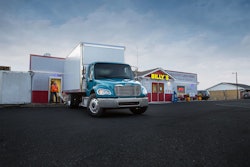Navistar on Tuesday launched its fully electric International eMV Series.
Available in 217-inch, 236-inch, 254-inch and 272-inch wheelbase, the eMV's battery electric motor provides peak power of more than 335 horsepower – or 250 kilowatts – with continuous power of 215 horsepower (160 kilowatts). The eMV features a 210 kilowatt capacity high voltage battery providing a range of 135 miles on a full charge.
The International eMV offers both AC and DC charging capabilities as standard. The recommended Level 2 AC charging station is suitable for overnight charging and provides roughly 19.2 kilowatts of power. The DC Fast Charge station option provides up to 125 kilowatt hours of power. The Fast Charge station also has the capability to provide multiple power options. At its highest kWh input, it can provide a full charge to the eMV in under two hours.
For supplemental charging, the eMV is equipped with three levels of regenerative braking, allowing the vehicle to collect kinetic energy from braking and store it in the battery. Batteries are packaged between the frame rails for additional protection and come with a five year or 100,000 mile warranty.
A digital instrument cluster includes information on propulsion and regenerative load, state of charge indicator and regenerative braking indicator.
International's NEXT eMobility Solutions, working alongside its dealer network, acts as "a complete ecosystem solution that will allow our customers to seamlessly integrate our EVs into their fleets and are confident the eMV will provide an extremely positive total ownership experience," said Gary Horvat, vice president of eMobility.
NEXT eMobility Solutions acts as a resource for customers, providing all-inclusive zero emissions education and assistance beginning with buyer consultation and continuing through vehicle end of life. NEXT provides support throughout the entire fleet electrification process including vehicle charging complexities like requirements for proper charging, suitable infrastructure partners, charging installations and collaborations with local power companies to ensure adequate power is available for vehicle charging.










